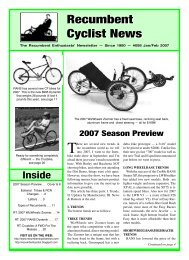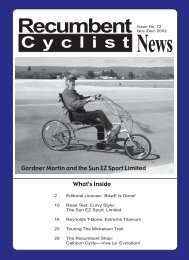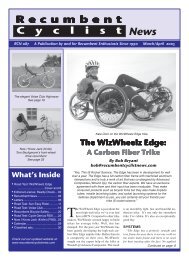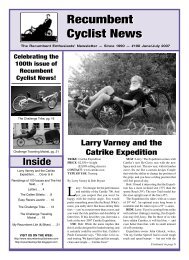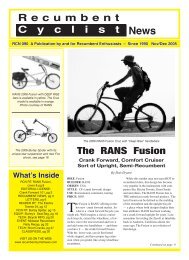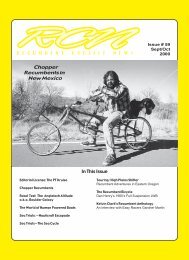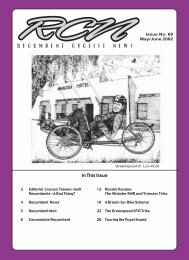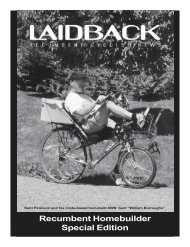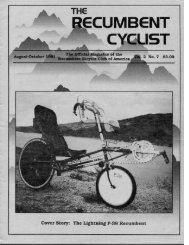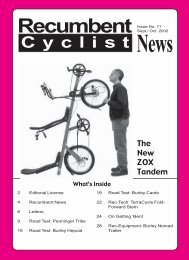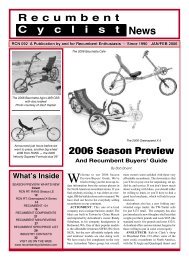C y c l i s t Recumbent - Steve Briggs
C y c l i s t Recumbent - Steve Briggs
C y c l i s t Recumbent - Steve Briggs
You also want an ePaper? Increase the reach of your titles
YUMPU automatically turns print PDFs into web optimized ePapers that Google loves.
Direct: These are independent handlebars<br />
that are mounted onto the kingpin assemblies<br />
combined with a connecting rod between the<br />
front wheels. This setup offers a very responsive<br />
(read: quick) and direct feeling steering.<br />
It is also lighter and simpler. This is becoming<br />
the industry standard because Catrike uses it<br />
on all models, and WizWheelz uses it on two<br />
models (Edge carbon fiber & Edge AL).<br />
Front End: Trike front-ends are simpler versions<br />
of what is on your car. The front wheels<br />
are held by kingpins, which spin on kingpin<br />
bushings (brass and sometimes plastic) or on<br />
bicycle headsets (ICE and Catrike). Headsets<br />
rotate fluidly and gracefully, and bushings have<br />
some friction and can dampen steering. Both<br />
are good systems and which you like best will<br />
be a matter of personal preference.<br />
Toe-In: This is the most crucial setting on<br />
your trike. This is the measurement at the inside<br />
most forward point of the front wheels,<br />
and the inside measurement at the inside back<br />
of the front wheels (half way up). Most trikes<br />
are set so the wheels are slightly toed in. If the<br />
wheels are toed out it could lead to handling<br />
problems.<br />
TRIKE STABILITY<br />
Performance: Weight is important to performance.<br />
Everything else being equal, the<br />
lighter trike will accelerate faster, sustain speed<br />
easier and be overall faster.<br />
There are other performance variables as<br />
well: Trikes with 16” wheels will accelerate<br />
faster, while those with 20” wheels will hold<br />
their speed better. The lower trikes will also<br />
be faster, but keep in mind that your personal<br />
comfort on the trike can overcome most of<br />
these minor details. Another factor is that<br />
trikes with more stable handling will be more<br />
controllable at speed.<br />
Stability: Trikes are unique and exactly<br />
what makes them stable can be a bit of a mystery.<br />
Also, the term stability means different<br />
things to different riders. In saying all that,<br />
imagine a trike is a 3D pyramid: width and<br />
length add stability, height takes away stability<br />
and a low center of gravity (or seat height)<br />
adds stability. This is a simplistic view, but you<br />
get the idea.<br />
Sixteen-inch wheels are lighter, more compact,<br />
accelerate faster, turn sharper and have<br />
become the wheels of choice for sporting trike<br />
riders. They add a degree of liveliness to the<br />
ride of any trike.<br />
Twenty-inch wheels are heavier, tougher,<br />
retain speed better and are more suited for commuting<br />
and touring. There are some old school<br />
performance trike designs that use 20” wheels.<br />
These can be very fast as well, but keeping<br />
the weight low is more difficult.<br />
Each trike rides a bit differently. What feels<br />
good to a newbie may not work for a seasoned<br />
enthusiast, so if possible ride as many as you<br />
can. If not, learn as much as you can, and try<br />
8 <strong>Recumbent</strong> Cyclist News<br />
to make a determination of what will work best<br />
for you.<br />
Handling: The way in which these trikes<br />
handle varies by model. I have found that 20”<br />
wheeled models with fixed seats and indirect<br />
linkage steering are handle the most predictably.<br />
Trikes from ICE and Greenspeed have<br />
the best handling, with WizWheelz being a<br />
close third. The WizWheelz does not have a<br />
fixed seat, and it has no triangulation, so the<br />
frame flexes more and offers a smoother ride.<br />
Direct-steered trikes are all very responsive<br />
and sporty handling at speed takes some getting<br />
used too. Direct-steered trikes also have<br />
more brake-steer. Riders can counteract this<br />
by applying a very slight forward pressure on<br />
the side on which they are braking. You must<br />
be very careful as you learn to control your<br />
trike at speed. These trikes are within the reach<br />
of most people, especially on flat, smooth<br />
roads and bike trails. Our concern is primarily<br />
for riding in traffic and fast descents.<br />
Handling at Speed: Controlling your trike<br />
at high speed will require: a trike with a very<br />
refined steering geometry and little brake steer,<br />
and/or careful and equal modulation of the individual<br />
brake levers to keep equal pressure<br />
on both brakes and/or road hazard avoidance.<br />
Braking modulation alone can limit how fast<br />
you are willing to descend steep hills. I’ve<br />
heard stories about new trike riders veering<br />
across traffic, and losing control and flipping<br />
over. Practice braking at speed, know your limits,<br />
watch the road, and ride with caution.<br />
WHEEL SIZES<br />
26”/20”: Years ago this was the standard<br />
wheel size for trikes. In the quest for performance,<br />
trikes got lower and the full-sized<br />
wheel seemed too large. I can recall sitting on<br />
a 26”/20” trike and having my head hit the rear<br />
tire or rack. Also, the larger rear wheel moves<br />
the center of gravity forward and makes the<br />
rear end light, which can make for tail-wheelies<br />
during hard braking. Trikes that utilize fullsize<br />
rear wheels are mostly long and stretched<br />
out models for racing.<br />
3x20”: This is the most common wheel combination.<br />
Most trikes use the 406mm BMX size<br />
20” which is a recumbent standard. It works<br />
best for new riders and commuters (strong<br />
wheels + robust tires) and is found on some<br />
performance trikes as well.<br />
3x16”: The 349mm 16” wheel has been the<br />
folding bicycle standard wheel for many years.<br />
It is smaller, lighter, accelerates faster (but<br />
doesn’t retain its speed as well), turns more<br />
sharply and allows for a lower trike and center<br />
of gravity. These are ideal for folding or<br />
take-apart trikes.<br />
349mm 16”/451mm 20”: This setup is used<br />
on the Catrike Speed and gets the front end<br />
lower. This results in all the benefits of the<br />
smaller 16” front wheels, but with the added<br />
gearing capabilities of the taller 451mm 20”<br />
front wheel (taller than the more standard<br />
BMX size 406mm 20” front wheel).<br />
FRAME MATERIALS<br />
Steel: Aircraft ChroMoly is the strongest<br />
frame material, it can offer a more cushioned<br />
ride (trikes with triangulated rear ends can also<br />
be very stiff), and has been the industry standard.<br />
Like the road and MTB worlds, this will<br />
probably eventually change. Steel frames are<br />
heavier and they will rust if not taken care of.<br />
Aluminum: Aluminum is lighter, and has a<br />
shorter fatigue life, is usually stiffer and it<br />
transmits more road shock. Carefully selected<br />
aluminum can make for a very light frame that<br />
is also affordable to build. Most aluminum<br />
trikes are heat-treated after they are welded to<br />
preserve the integrity of the material. Also, aluminum<br />
does not rust. The downside is that it<br />
cannot be repaired once heat-treated. The upside<br />
is a trike that weighs 10 or more pounds<br />
less than steel.<br />
FRAME/SEAT DESIGN<br />
Fixed Seats: Catrike and some non-folding<br />
Greenspeed models have fixed seats that are<br />
an integral part of the frame, and the seat frame<br />
connects the rear stays to the cross-member.<br />
This rigidity makes for better high speed stability<br />
and less tensional twisting in the frame.<br />
However, it can also make the ride stiffer.<br />
Bolt-On Seats: These are used for easily<br />
transportable trikes (Greenspeed GT-3/5) and<br />
with trikes where the seat (instead of the boom)<br />
slides for rider adjustment. These are really the<br />
only reasons to have a bolt-on seat. Both are<br />
necessary tradeoffs if you need a folding trike<br />
or want a sliding seat (with no chain or boom<br />
length adjustments required).<br />
Seat Recline: Racing and performance<br />
trikes have seat recline angles of 20º to 35º<br />
and are often fixed (integral seats). These can<br />
be difficult to get accustomed too, but make<br />
for very fast and aerodynamic riding positions.<br />
Touring, commuting and recreational trikes<br />
have seat angles of 35º to 40º or more. Trikes<br />
like the ICE budget series (T, Q, & S) and<br />
WizWheelz have adjustable seat angles. I develop<br />
neck and shoulder pain when my neck<br />
is cocked forward (chin to chest) too far. If the<br />
seat is reclined too much more I develop pain<br />
after 60 to 90 minutes of riding. For me 35º to<br />
40º is perfect. Some riders are not bothered by<br />
this at all. As a default, new trike riders should<br />
choose a more upright position unless they already<br />
know what works (for instance, if you<br />
already own a recumbent with a very laid-back<br />
position).<br />
Headrests: Several manufacturers offer<br />
head- and neck- rests for models with very laidback<br />
seats where you have to bend your neck<br />
(chin to chest) to look straight ahead. Headrests<br />
are probably unnecessary on models with<br />
more upright seats. Headrests don’t always<br />
work as intended. Many interfere with the back



